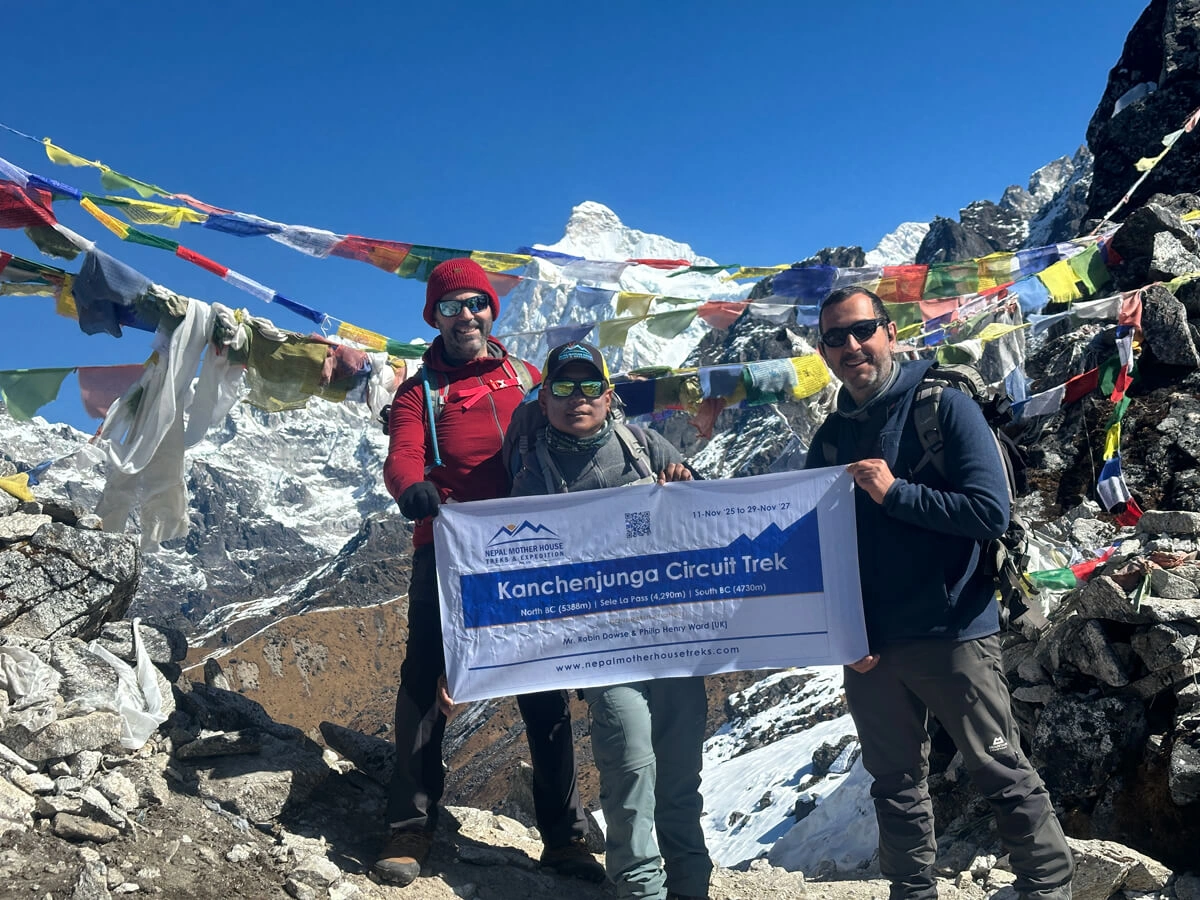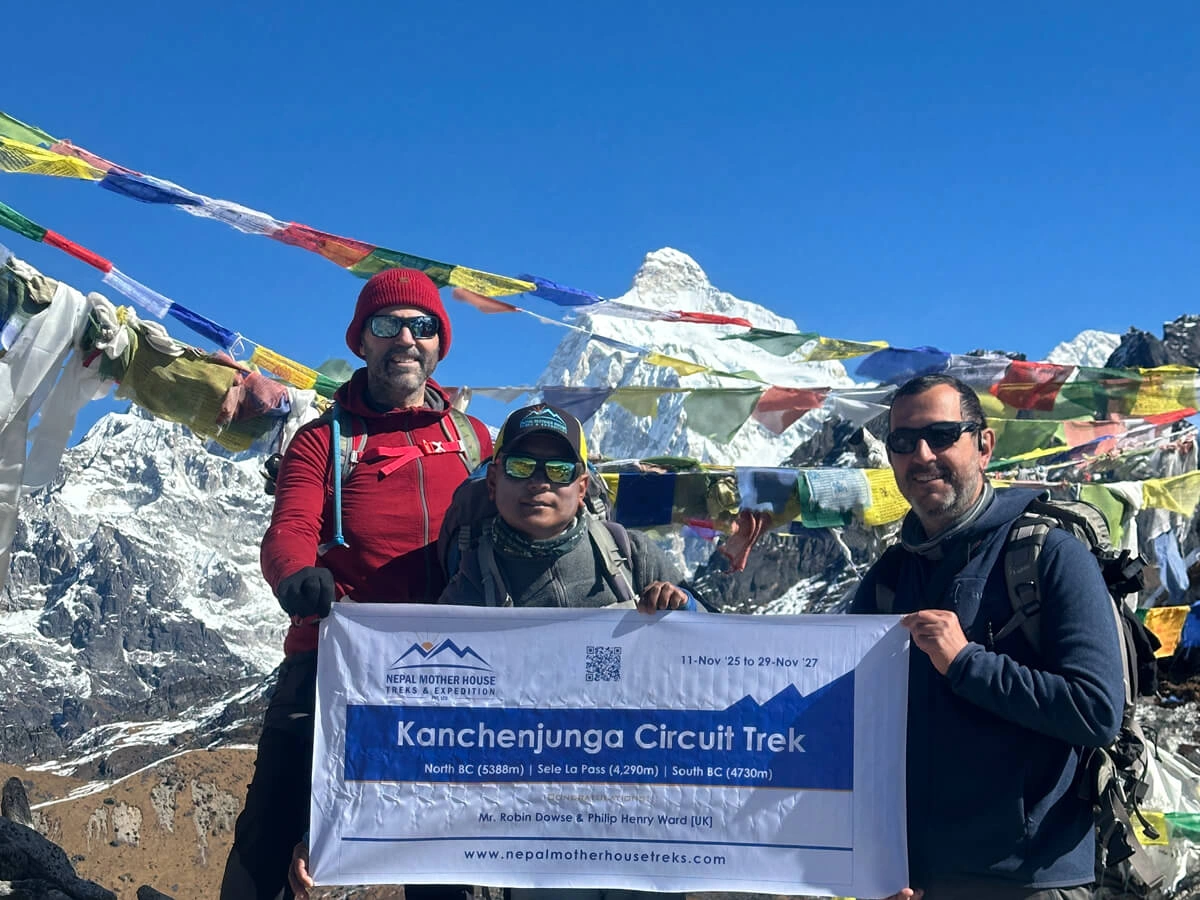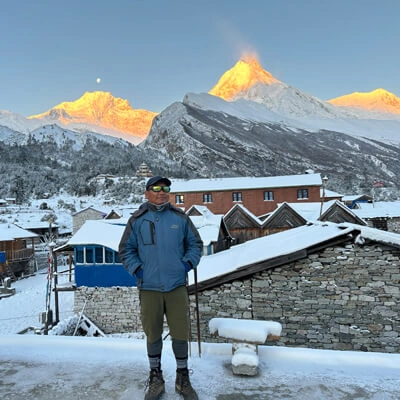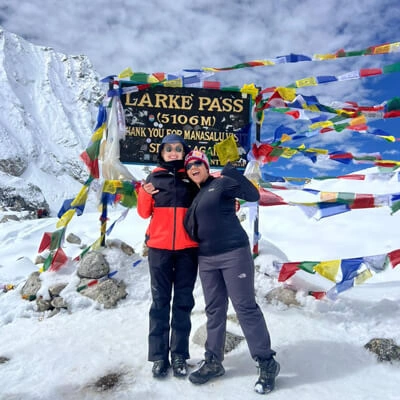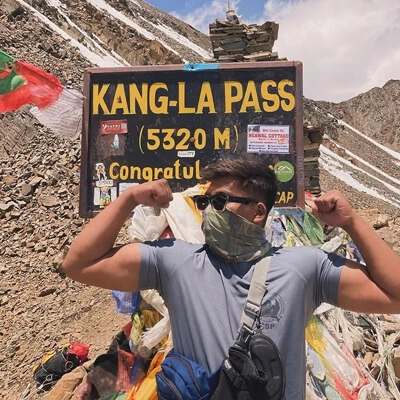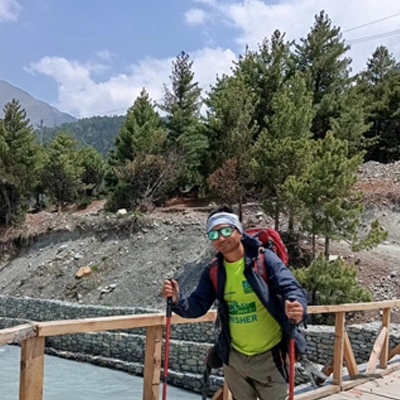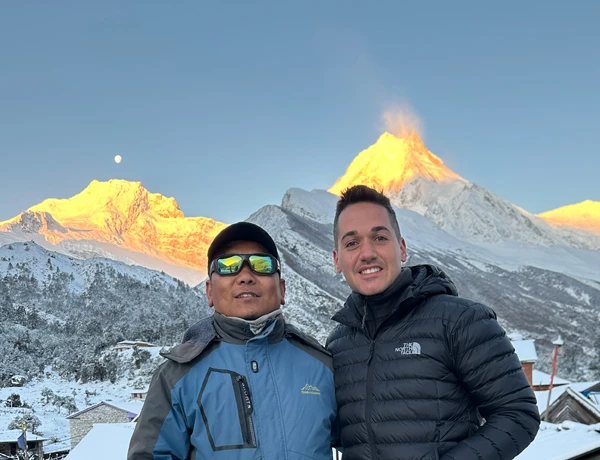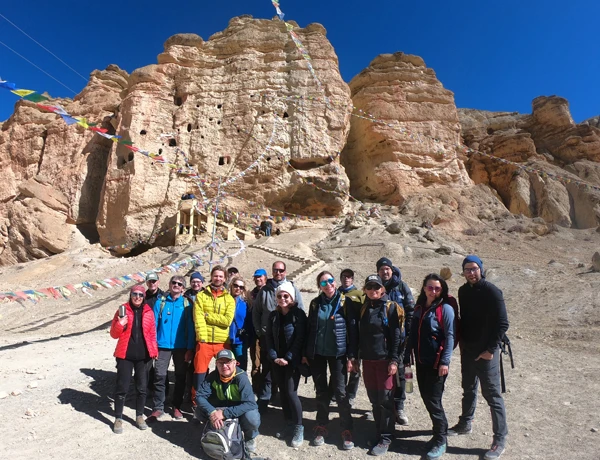Kanchenjunga Circuit Trek is located in the eastern part of Nepal; it borders Sikkim and Tibet, and the trail goes around the lap of the “3rd Highest Mountain in the World,” Mt. Kanchenjunga (8,586 m). As Kanchenjunga Base Camp Trek is one of the shortest forms of tea house trip in the Great Himalaya, it offers various experiences from the lowest point of Nepal, “Kechana Kawal,” 58 meters at Jhapa, to the top of Mount Kanchenjunga (8,586 m) with amazing snowcapped mountain scenery, miracle glaciers, tranquil glacier lakes, high Lander Sherpa’s unique culture and tradition, and rarely spacious Red Panda and Snow Leopard.
Most of the short trekking routes in Nepal are overcrowded during tourist peak season due to trigger plans by all trekkers simultaneously. And access to wilderness trekking requires more days to get to the remote Himalayas. Every trekking proposal ideally offers an escape from the daily grind and daily life, allowing one to enjoy nature and culture while rejuvenating. In this Kanchenjunga Circuit Trek, we at Nepal Mother House offer you an off-beaten-track trip in the Himalayas in the shortest time. Most of the day, you need to walk longer compared to other normal trekking itineraries. So, you must well prepare physically and mentally before this trek.
The Kanchenjunga Circuit Trek begins in Taplejung after a short flight from Kathmandu to Bhadrapur/Biratnagar and drives to Taplejung on the same day of the flight. In this trek, first, you will visit Kanchenjunga North Base Camp (5,388 m) following Tamor River Bank through the villages of Limbu ethnic people: Mitlung, Sinwa, Chiruwa, Tapethok, Lelep, Sukathum, and turn right through the bank of Gunsa Khola. Walk by Amjilosa, Gyabla, Phale, Gunsa, Khambachen, Ramtang, and Lhonak, inhabited by Sherpa villages and the Botiya people, who have been following a hundred years of Tibetan culture and tradition and practicing Buddhism.
During a rest for acclimatization day at Khambachen, it would be best to hike to Jannu viewpoint (4,400 m), from where you can see the outstanding view of many mountains: Ghabur Peak (6,044 m), Phile (6,645 m), Sobi Thongie (6,670 m), Mera Peak (6,364 m), including Mt. Kumbhakarrna mountains. This is the place where the profound serenity of Kirat can be witnessed beneath the boulders. It is the place where Maha Guru Phalgunanda used to meditate. He was born on November 11, 1885, in Chukchinamba village, Ilam district, Nepal, and transcended the physical realm on April 4, 1949, but his presence is still felt through his meditation at this location.
According to the revered Great Master Phalgunanda, this site holds great spiritual significance for the Kirati people, known as the "Holi site" (Phaktanglung's shape of a man's shoulder). The shape of Mt. Kumbhakarna is similar to the shoulder. It is believed that every Kirati individual must visit this place at least once in their lifetime. Originally, the name Mount Kumbhakarna comes from an interesting character in the Ramayana; he was one of the demon brothers of Ravana.
As the view of Khumbhakarna is most significant from here, sometimes people call a Kumbhakarna viewpoint as well for the Jannu. Kanchenjunga North Base Camp itself, Kanchenjunga Glacier, and other mountain scenery are additional attractions of this trek. Then heading back to Ghunsa for the next part of the trek, Kanchenjunga South Base Camp crosses over the Sele La Pass (4,290 m) and visits Yalung Base Camp (4,500 m), known as Kanchenjunga South Base Camp, via Cheram, Yalung Bara, Lapsang, Ramche, and Okta.
South Base Camp is best in terms of mountain scenery and wonderful views from the North West side to the southeast, respectively: Boktoh (6,114 m), Nyukla Lachung (6,810 m), Kumbhakarna (Jannu) (7,711 m), Kanbachen (7,802 m), Yalung Kang (8,505 m), Kanchenjunga (8,586 m), Kanchenjunga Central (8,482 m), Kanchenjunga South (8,476 m), Kabru I (7,412 m), Kabru II (7,339 m), Kabru III (7,338 m), Kabru IV (7,318 m), Rathong (6,682 m), Kokthang (6,148 m) and Khangla Khang (5,582 m). The trail is coming down, taking a couple of days to the Tortong through the Cheram and Ramche and getting back to the Trekking starting point at Lelep/Hellok, taking a new route. Then drive back to the most popular tea state, Ilam, for an overnight stay, and the next morning drive to Bhadrapur to fly back to Kathmandu.
Likewise, the Tamor Corridor Highway for the Tibet Border at Olangchung Gola is almost ready. After a complete highway, it is possible to drive through the Bhedetar by private Jeep through the Tamor corridor, which takes 9 to 10 hours. We stay overnight at Bhedetar of the Hill station and fly back to Kathmandu from Biratnagar in the afternoon of the following days. Then departure for your destination onward.
Kanchenjunga Base Camp Trek is a recently opened teahouse trek in the Himalayas, so there are very basic accommodation facilities and a choice of food available. In this Kanchenjunga Short Trek package, we at Nepal Mother House aim to provide access to venture journeys in the remote high Himalayas in the shortest time possible. Kanchenjunga Circuit Short Trek can take a minimum of 17 days to above 4 weeks, according to your holiday requirements and the cost of expatriation. We are glad to organize the Kanchenjunga Tea House Trek year-round by local Sherpa guides and porters to promote sustainable eco-tourism and local empowerment with the required permits and paperwork. But it is recommended that March-April-May and September-October-November be the best time and batter to high altitude previous experience or physical fitness for this trek. Why not join us for Kanchenjunga Base Camp trekking for local empowerment?
Do I Need Physical Fitness and Preparations for the Kanchenjunga Trek?
The trek goes into the high Himalayas, following a rugged trail with several ascending and descending sections for multiple days. The hike in the high Himalayas could be painful due to the thin air and cold if you are not properly physically fit. It is the best idea to involve physical exercise before your trekking, which makes your body strong and fit. As a result, this will help you get to your destination with less stress.
While walking for a multi-day trek in the Himalayas, you might be facing muscle soreness, blisters, joint pain, and back pain. This makes you very uncomfortable and sometimes causes you to abandon your trip in the middle of the trail. So, you need physical exercise beforehand before the trip begins. It would be best to exercise at least a month before your trek. Cardio exercises like running, jogging, hiking, long walks, cycling, climbing stairs, and swimming are best for the exercise. You may carry a light backpack along with you and hike for a couple of hours every weekend to get used to it. Likewise, you may go to the gym and work out, which can also be a good option to prepare for the trek. Do not overdo it in one day; instead, exercise regularly to keep your body in shape.
Normally, an easy trek does not require a high level of physical fitness. Still, the earlier exercises are a good choice. You are going on the Kanchenjunga Circuit Trek, which is moderate to strenuous, so you will need to be well-trained to make the trip more enjoyable and memorable.
Transport for the Kanchenjunga Circuit Trek
The Kanchenjunga Circuit Trek is a wilderness trek in eastern Nepal. Adventurers are increasingly choosing this trek to immerse themselves in the beauty of Mother Nature. Similarly, Taplejung is Nepal's most popular tourist destination because of the Pathibhara Devi Temple, which attracts thousands of pilgrims from Nepal and around the world every day. There are a few ways to get to the Kanchenjunga Circuit Trek:
[I] Drive by bus from Kathmandu to Taplejung.
If you want to travel on a budget, regular buses depart from the New Bus Park in Gongabu. The long bus ride to Taplejung takes 20 to 23 hours via the Prithvi Highway, Narayanghat, Hetauda, Koshi Barrage, Itahari, Birtamod, Charali Jhapa, and Ilam.
[II] Kathmandu to Taplejung by Jeep
After completing the BP Koirala highway drive from Kathmandu to Sindhuli, Bardibas is another option to get to Taplejung; it saves a huge amount of time and money. Nowadays, you can drive from Kathmandu to Taplajung in 11 to 12 hours’ drive by Jeep. Even so, drive from Dharan to Taplejung through the Tamor Corridor for a short time.
[III] Fly Kathmandu to Bhadrapur and drive to Taplejung
For comfort travel, there are regular flights from Kathmandu to Biratnagar, Tumlingtar, or Bhadrapur, then drive to Taplejung by bus or private jeep, taking 8 to 9 hours via Ilam. This route is mostly used for the Kanchenjunga Base Camp Trek.
[IV] Kathmandu to Suketar/Taplejung Direct Flight
Ground transport from Kathmandu to Taplajung is quite a long journey of about one full day and night, so this won’t be suitable for you. Then there is another airport at Suketar with a 2/3 flight in a week, which is the best option for the Kanchenjunga trek in the shortest way. As there is no regular daily flight, they do only charter flights except their schedule. Flight Kathmandu-Taplejung-TapleJung-Kathmandu Sita Air's plane will fly every Monday, Wednesday, and Friday from January 18, 2023 (Magh 4th, 2079). Similarly, Nepal Airlines (RA) also conducted a fight at Suketar. The cost of the flight is Rs. 9,295 to 10,500 for domestic tourists and USD 212 for international tourists.
With various options to get to Taplejung, I would like to recommend you fly from Kathmandu to Biratnagar for 30 to 36 minutes, drive 5 to 6 hours by private vehicle through the Tamor Corridor via Dharan at the beginning of the trip, and conclude the trip at Ilam via Yamphudin, Khebang (1910 m), Hapukhola, and fly from Bhadrapur to Kathmandu for your destination.
Plan Your Trip at the Best Time
In Nepal, we have mainly two trekking seasons: spring (March, April, and May) and autumn (September, October, and November). Autumn is one of the best trekking seasons; the weather is perfect with pleasant temperatures and falls during many festivals, especially Dashain and Tihar. So, most trekkers trigger their plans during this time. Likewise, spring is nature's blooming season, full of rhododendron flowers and greenery everywhere. If you are looking for different vegetation and flowers beneath the gigantic Himalayan range, spring is perfect. Most of the expeditions operated during the spring season; you may see some expedition groups in the Kanchenjunga Base Camp as well.
Monsoon and winter are not good times for the Kanchenjunga Circuit Trek. If you visit here during the winter, it will be cold in the high elevation, and the monsoon will drop a lot of rain, which might be the cause of blocking the road by the landslide of the flood. Still, if you want to try this season, we are here to support you.
Difficulties Level of Kanchenjunga Circuit Trek
Kanchenjunga is wilderness trekking in the lap of the Himalayas with a less frequented trail. The trek can be completed in 17 days in the shortest amount of time, and it can extend for 4 weeks as well. As there is a lot of ascending and descending the following river, rocky hills, and jungles, the trekkers often feel exhausted in the middle of the journey. So, you need to be mentally well-prepared and physically fit before the trek. This is moderate to strenuous trekking; the trail goes through high passes, glaciers, and rocky trails, so it is not easy.
The trail frequently goes up and down on the same day's walk. Some parts of the trail are very steep and risky with loose rock. You need to be careful while crossing the landslide area, glaciers, and narrow rock trails. Even our crew and experienced guide will lead you on a better trail, trying to mitigate less risk. Some days you need to walk for 8 to 9 hours to traverse the passes at high elevation. You need to be physically fit and well-prepared for the Kanchenjunga Circuit Trek.
Safety and Security on the Kanchenjunga Sele La Pass Trek
Yaks, Mules, and Dzo/Jopke (a cross between the yaks and cow) are means of transportation in the Himalayas. People use them to carry food and material supplies into the hotel. The 17-day Kanchenjunga Sele La Pass Trek trail goes through the jungle, hills, rocks, and glaciers and crosses a suspension bridge. Somewhere, when crossing the narrow trail with the herd of yaks, mules, and trekkers, you must be careful when passing through them and should stay in the safe zone. Sometimes, people don’t care when they are taking photographs in a risky area; you should make sure there is sufficient space and no cliff. Don’t go closer to animals like Yaks, dzos, cows, and buffalo; they might attack you anytime.
During the trekking season, many trekkers and porters carry loads on their way. While meeting them on the narrow surface and bridge, you must be sure that there is a safe zone on the corner side of the trail, and if you stand at the edge of the trail, it is more risky to be pushed to the cliff by them. Likewise, carry yourself the most important documents and goods, such as passports, insurance policies, credit cards, cameras, mobile phones, and other valuable things.
Can we make the Kanchenjunga Circuit Trek shorter than 17 days?
Sure!! Wandering around the Himalayas and taking sufficient time is the best way to explore the hidden treasure. However, if you are looking to visit both the base camps of the Kanchenjunga south and north in the shortest time, this trek can also be made shorter. The Kanchenjunga Trekking Routes can be different depending on where you would like to visit. And it depends on the trekking starting point. On the north side, the road leads up to the Sukathum, which is 3 days of trekking from Taplejung. If you are taking Kathmandu to Suketar on a direct flight both ways and driving to Sukathum, then it can be completed in 13 days. The Kanchenjunga Circuit Trek is also the shortest.
Likewise, as there is road access three walking days beyond the Taplajung on the Kanchenjunga Base Camp southside, it is possible to drive to Yamphudin by Jeep, which already makes several days shorter on your trek as a 7-Day Kanchenjunga Short Trek. During monsoon and rainy days, the road might be drivable due to landslides and floods blocking off-road. Other times, we can get a Jeep on the route but need to wait until the Jeep is full; sometimes it may take an hour to a couple of hours to collect passengers. If you are willing to bear some extra cost to make it private, then you can drive at any time according to your schedule.
Likewise, at the end of the Kanchenjunga Sele La Pass Trek, you can walk back to Sukathum from Cheram, and the next day you can catch the Jeep to Taplejung. Despite the long walk through the jungle and isolated region, it is an enjoyable trekking day. As there is no teahouse facility, you need to pack lunch on this day. In this way, you can do the Kanchenjunga Trek in 13 days.
Why are we not taking Kathmandu to Suketar (Taplejung) by direct flight rather than Kathmandu to Bhadrapur?
You are right! There are direct flights to Suketar (Taplejung) by Sita Airlines and NA (Nepal Airlines) every morning at 8 a.m. Flying to Suketar Airport at Taplejung is one of the best ways to escape the long drive from Bhadrapur to Taplejung, and it reduces the whole day for the Kanchenjunga Circuit Trek. However, we at Nepal Mother House Treks aim to provide the best experience of Nepal. During this flight, you have a test of the lowland to the world's third-highest mountain, Mt. Kanchenjunga, with its geographical diversity of Nepal and various cultures. On the trip, you will visit one of the lowest points, Kechana Kalan in Jhapa, at an elevation of 60 meters from sea level to Kanchenjunga North Base Camp (5,388 m). Meanwhile, you will visit the Certified Organic Tea State of Nepal, established in 1863, people in different places, and the Nepal Jeep driver experience.
Accommodation and Tea House Condition in Kanchenjunga Circuit Trek
The recently opened Kanchenjunga tea house trek is located in a remote area in the Himalayas. There are basic facilities available, such as toilets, bathrooms, and lodgings. Suketar and Gunsa have proper hotels with all amenities, but the rest of the places have very basic facilities. Except for a few places, the hot shower is provided in buckets. Lhonak is the last tea house in the north part of the Kanchenjunga Base Camp, and Ramche in the south base camp offers very basic accommodation and meals. Likewise, on the Sele La Pass at High Camp, there are two tea houses available to accommodate ten to fifteen trekkers. The trekkers visit Kanchenjunga to enjoy nature's beauties in a lonely way. So, already know about the Kanchenjunga Circuit Trek accommodation condition. Sometimes they will sleep in the room with local people and offer them the local food they are having.
What Food Is Available on the Kanchenjunga Base Camp Trek?
Due to the newly developed tea house Kanchenjunga Base Camp Trek, there are very basic food items available. The breakfasts and dinners will be at the tea house where you are staying, and lunch will take you on the way. Most of the tea houses do not have menu cards either, so they prepare Nepalese food like “Dal Bhat," boiled and fried potatoes, and bread. Tibetan foods, common continental dishes, and occasionally Indian foods can be offered at tea houses or lodges.
Best Places to Visit during Kanchenjunga Trek
Don't overlook the most popular viewpoint, offering a mesmerizing view of Mt. Kanchenjunga (8,586 m), the third highest mountain in the world. Normally, Kanchenjunga North Base Camp, Kumbhakarna/Jannu View Point (4,400 m) from Khambachen, Sele La Pass, and South Base Camp are well recognized in Kanchenjunga Trek. However, some of the best viewpoints have opened for trekkers.
Dromo Ri (6,000 m) is one of the best viewpoints for the spectacular 3rd-highest mountain on earth. For this viewpoint, you do not need any special permits; trekking permits can be obtained; however, you need an expert guide or a local guide to explore the trail. It lies in Kanchenjunga North Base Camp, a ridge of the Dromo Ri Peak (6,855 m), which takes 3 to 4 hours from Pangpema without any major difficulty or technical gear. As there is no proper tea house for overnight stays at Pangpema, you need to stay at Yaks sheds or a tented camp if you have one. Otherwise, it is possible to start hiking from the last tea houses in Lhonak and climb to Dromo Ri, which takes 2 to 3 hours more.
Cost of Kanchenjunga Circuit Trekking
What services you would like to have, such as hiring a guide and porter, a porter for each trekker, transportation, and how many days of trekking you would like to do, will affect the cost of the Kanchenjunga Circuit Trek. Normally, most trekkers hire a professional trekking guide and experience a porter for every two trekkers. Likewise, most of the trekkers like to fly Suketar at Taplejung; however, sometimes the flight is not sure due to the weather in Suketar. So, it would be best to fly from Kathmandu to Bhadrapur and drive to Taplejung on the same day.
The price will be almost similar to flying to Suketar or Bhadrapur when getting to Taplejung. The trekking permit fee also makes trip costs different, which is not often changed. Kanchenjunga Circuit Trek Itinerary and its duration also affect the cost of the trip. The Kanchenjunga Trekking cost will be different now and after six months or next year. However, we at Nepal Mother House are glad to offer you a pre-trip booking for the next year 2026 or 2027, or the coming spring (March, April, May) and autumn (September, October, and November) 2026.
Packing Lists for the Kanchenjunga Circuit Trek: Trekking Equipment
The Kanchenjunga Circuit Trek offers an adventurous journey along an unexplored route in the eastern region of Nepal. The trip begins at Bhadrapur, an elevation of 91 meters, and ascends to the Taplejung via the beautiful tea state of Ilam. And goes to Kanchenjunga North BC (5,388 m) and Yalung Base Camp/South Base Camp (4500 m) via Sele La Pass (4,240 m) with various landscapes of the lowest level 65 m at Kenchena (Jhapa) to the top of Kanchenjunga (8,586 m). You had a great experience with geographic diversity during the 17-day trek. For this journey also, you need similar trekking gear, like Everest Base Camp Trek.
However, for the first day, it will be boiling during springtime and the beginning of autumn. You need a thin cloth and a cool cotton cloth to save from heat. And when it gets higher, the temperature will drop accordingly. Trekking gear is most important for you to make the trip successful. The trip won’t be a pleasure without good trekking equipment, and it may not succeed. So, you must have chosen good trekking gear for the trek. Sleeping bags and down jackets must be accommodating in temperatures of -5 degrees Celsius.
Most trekking gear can be bought in Thamel at a reasonable price. If you would like to use it for another trip in the future, then it would be better to buy it in your country or from a branded trekking gear company (North Face, Mountain Hard Wear, Sherpa Gears, Raiko, etc.).
Otherwise, you can buy Nepali products in Kathmandu as well. Some trekking shops provide hiking services too.
Highlights
- One of the shortest treks on the Kanchenjunga Circuit.
- The 3rd highest mountain in the world, Kanchenjunga, is 8,586 meters in elevation.
- Less frequently trekking routes by trekkers.
- newly developed Tea House trek in the Himalayas.
- A Part of Great Himalayan Trail.
- Home of rarely specious Red Panda and Snow Leopard.
- Amazing mountain scenery and Landscape.
- Unique Culture and Tradition of Well-known Sherpas.
- Visit North & South Base Camp via Sele La Pass (4.240 m)
- The landscape of the lowest level is 58 m at Kenchena (Jhapa) to the top of Kanchenjunga at 8,586 m.
- Visit the most popular Jannu View Point (4,400 m), Kirati people, known as the "Holi site" (Phaktanglung).


